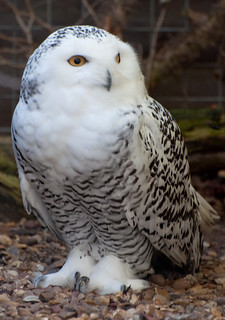Snowy owls are quite majestic birds of prey. They are large in size and their white faces with brown coloring on the body make for a stunning bird watching opportunity. Because these birds prefer arctic conditions, bird enthusiasts in the United States rarely get a chance to spot them. Occasionally, a snowy owl is seen in the most northern states, but they tend to stay in within the Canadian borders. However, towards the end of November last year, there were many more sightings than normal, and much further south than was ever expected. The furthest south a snowy owl was seen this winter was in Florida.

CC Image courtesy of Will Thomas / Forge Mountain Photography on Flickr
David Brinker, a biologist from the Maryland Department of Natural Resources, almost couldn’t believe his eyes when he saw two snowy owls on a small beach in Maryland. “Something huge is going on,” he said to his team. “We won’t see something like this for a long time – probably for the rest of our lifetimes.” This massive boom in population is the biggest recorded on the east coast in around half a century.
“This winter has brought an unexpected invasion from the North, the largest migration of snowy owls observed in decades. The Arctic birds usually winter in Southern Canada, but this year they’ve been spotted as far south as Florida. As NPR’s Adam Cole reports, scientists are taking advantage of this unexpected visit by equipping a few of the owls with GPS tracking devices,” explained David Greene from WGBH News.
The snowy owl population naturally fluctuates from year to year with fairly predictably patterns with peaks every 4 years or so. This massive increase in owls can be traced to a recent over population of lemurs. Lemurs are rat-like mammals that are a favorite prey of arctic snowy owls. The abundance of lemurs essentially carpeted the canadian tundra. The owls killed way more than they could eat, and actually created nests out of the uneaten carcasses. With an abundance of food, the snowy owls thrived and laid nearly double their normal number of eggs. The baby owls were born with plenty to eat and grew into fat, healthy adult owls.
“They will eat pretty much anything they can jam down their throats – ducks, gulls, geese, muskrats, great blue heron,” explained owl expert, Scott Weidensaul. They’re a very big, very strong, very capable predator. On the Delaware coast, they were seen feeding on a dolphin carcass. That’s a new behavior we’re documenting this year.” Researchers jumped at the opportunity to study more of the snowy owls.

CC Image courtesy of Harlequeen on Flickr
“So Brinker and Weidensaul launched Project Snowstorm, their goal was to tag as many owls as possible with GPS transmitters,” Adam Cole reported to WGBH. “By studying the owl’s movements – for example the fact that they hang out at airports, the scientists hope to better understand their behavior and protect them from hazards. In less than two weeks, Project Snowstorm managed to cobble together a national team of volunteers and $20,000 in donations.”
Researchers trapped the owls carefully and took various measurements before attaching a tracking collar. “Then comes the GPS transmitter,” Cole added. “It’s a small light box that fits easily in the palm of your hand and it’s equipped with a solar panel and a chip that can hold five years worth of data. The owl wears it like a backpack with two thin Teflon straps wrapping around her wings. Brinker carefully sews the straps by hand so they fit the owl’s frame and don’t interfere with flight.”
“The owl takes off, gliding out into the dunes. Already her GPS unit is collecting data – longitude, latitude and altitude every half hour, and every three days her transmitter and the transmitters of the other 15 owls tagged so far will connect to a cell phone network and send all their data back to Project Snowstorm,” Cole said.
The GPS tracking devices will record the owls’ flight back north to the arctic and hopefully shed some light into how to best protect them in the coming decades. Climate change is already affecting the Arctic, where snowy owls live most of the year. Finding ways to protect the lemmings, the snowy owl’s primary source of food. In parts of Greenland and Scandinavia the lemming population may already be dropping, according to the Washington Post.
Snowy owls are amazing and beautiful birds of prey. Spotting these gorgeous owls thrills experienced bird watchers and the average Joe alike. Their white feathers, which serve to disguise them in the snowy Arctic, stand out stunningly in most other settings. We can only hope for another boom in the snowy owl population so that us U.S. citizens might have another chance to gaze upon the snowy owls in the wild. However, if another boost like this were to occur, it probably wouldn’t be for another 40 to 50 years.
Researchers Use GPS Tracking After Lucky Boom In Snowy Owl Population

No comments:
Post a Comment